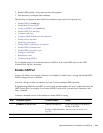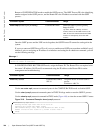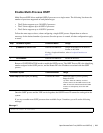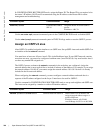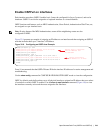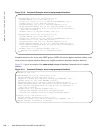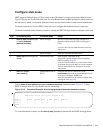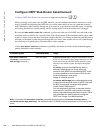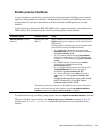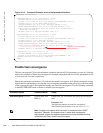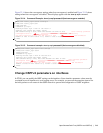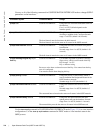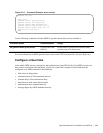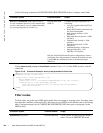
Open Shortest Path First (OSPFv2 and OSPFv3) | 713
Enable passive interfaces
A passive interface is one that does not send or receive routing information. Enabling passive interface
suppresses routing updates on an interface. Although the passive interface will neither send nor receive
routing updates, the network on that interface will still be included in OSPF updates sent via other
interfaces.
Use the following command in the ROUTER OSPF mode to suppress the interface’s participation on an
OSPF interface. This command stops the router from sending updates on that interface.
To enable both receiving and sending routing updates, enter the
no passive-interface interface command.
When you configure a passive interface, the
show ip ospf process-id interface command (Figure 413)
adds the words “passive interface” to indicate that hello packets are not transmitted on that
interface.
Command Syntax Command Mode Usage
passive-interface {default |
interface}
CONFIG-ROUTER-
OSPF-id
Specify whether all or some of the interfaces will be passive.
Default enabled passive interfaces on ALL interfaces in the
OSPF process.
Entering the physical interface type, slot, and number enable
passive interface on only the identified interface.
• For a Gigabit Ethernet interface, enter the keyword
GigabitEthernet followed by the slot/port information
(e.g. passive-interface gi 2/1).
• For a port channel, enter the keyword port-channel
followed by a number from 1 to 255 for TeraScale and
ExaScale, 1 to 32 for EtherScale (e.g. passive-interface
po 100)
• For a SONET interface, enter the keyword sonet
followed by the slot/port information (e.g.
passive-interface so 2/2).
• For a 10-Gigabit Ethernet interface, enter the keyword
TenGigabitEthernet followed by the slot/port
information (e.g. passive-interface ten 2/3).
• For a VLAN, enter the keyword vlan followed by a
number from 1 to 4094 (e.g. passive-interface vlan
2222).
E-Series ExaScale platforms support 4094 VLANs
with FTOS version 8.2.1.0 and later. Earlier
ExaScale supports 2094 VLANS.
The default keyword sets all interfaces on this OSPF process as passive. The passive
interface can be removed from select interfaces using the no passive-interface
interface command while passive interface default is configured.



